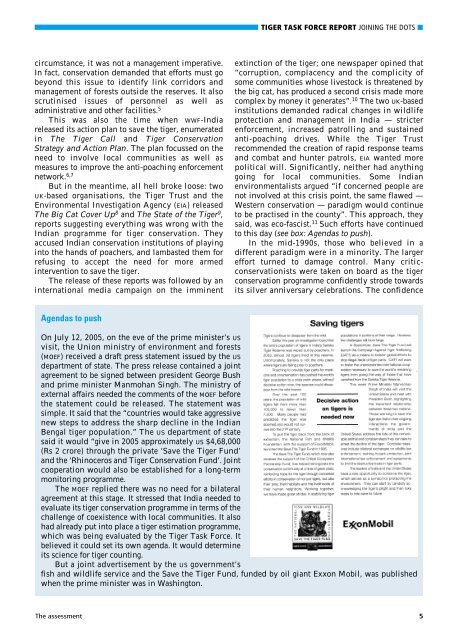Report of the Tiger Task Force - PRS
Report of the Tiger Task Force - PRS
Report of the Tiger Task Force - PRS
You also want an ePaper? Increase the reach of your titles
YUMPU automatically turns print PDFs into web optimized ePapers that Google loves.
TIGER TASK FORCE REPORT JOINING THE DOTS ■circumstance, it was not a management imperative.In fact, conservation demanded that efforts must gobeyond this issue to identify link corridors andmanagement <strong>of</strong> forests outside <strong>the</strong> reserves. It alsoscrutinised issues <strong>of</strong> personnel as well asadministrative and o<strong>the</strong>r facilities. 5This was also <strong>the</strong> time when WWF-Indiareleased its action plan to save <strong>the</strong> tiger, enumeratedin The <strong>Tiger</strong> Call and <strong>Tiger</strong> ConservationStrategy and Action Plan. The plan focussed on <strong>the</strong>need to involve local communities as well asmeasures to improve <strong>the</strong> anti-poaching enforcementnetwork. 6,7But in <strong>the</strong> meantime, all hell broke loose: twoUK-based organisations, <strong>the</strong> <strong>Tiger</strong> Trust and <strong>the</strong>Environmental Investigation Agency (EIA) releasedThe Big Cat Cover Up 8 and The State <strong>of</strong> <strong>the</strong> <strong>Tiger</strong> 9 ,reports suggesting everything was wrong with <strong>the</strong>Indian programme for tiger conservation. Theyaccused Indian conservation institutions <strong>of</strong> playinginto <strong>the</strong> hands <strong>of</strong> poachers, and lambasted <strong>the</strong>m forrefusing to accept <strong>the</strong> need for more armedintervention to save <strong>the</strong> tiger.The release <strong>of</strong> <strong>the</strong>se reports was followed by aninternational media campaign on <strong>the</strong> imminentextinction <strong>of</strong> <strong>the</strong> tiger; one newspaper opined that“corruption, complacency and <strong>the</strong> complicity <strong>of</strong>some communities whose livestock is threatened by<strong>the</strong> big cat, has produced a second crisis made morecomplex by money it generates”. 10 The two UK-basedinstitutions demanded radical changes in wildlifeprotection and management in India — stricterenforcement, increased patrolling and sustainedanti-poaching drives. While <strong>the</strong> <strong>Tiger</strong> Trustrecommended <strong>the</strong> creation <strong>of</strong> rapid response teamsand combat and hunter patrols, EIA wanted morepolitical will. Significantly, nei<strong>the</strong>r had anythinggoing for local communities. Some Indianenvironmentalists argued “if concerned people arenot involved at this crisis point, <strong>the</strong> same flawed —Western conservation — paradigm would continueto be practised in <strong>the</strong> county”. This approach, <strong>the</strong>ysaid, was eco-fascist. 11 Such efforts have continuedto this day (see box: Agendas to push).In <strong>the</strong> mid-1990s, those who believed in adifferent paradigm were in a minority. The largereffort turned to damage control. Many criticconservationistswere taken on board as <strong>the</strong> tigerconservation programme confidently strode towardsits silver anniversary celebrations. The confidenceAgendas to pushOn July 12, 2005, on <strong>the</strong> eve <strong>of</strong> <strong>the</strong> prime minister’s USvisit, <strong>the</strong> Union ministry <strong>of</strong> environment and forests(MoEF) received a draft press statement issued by <strong>the</strong> USdepartment <strong>of</strong> state. The press release contained a jointagreement to be signed between president George Bushand prime minister Manmohan Singh. The ministry <strong>of</strong>external affairs needed <strong>the</strong> comments <strong>of</strong> <strong>the</strong> MoEF before<strong>the</strong> statement could be released. The statement wassimple. It said that <strong>the</strong> “countries would take aggressivenew steps to address <strong>the</strong> sharp decline in <strong>the</strong> IndianBengal tiger population.” The US department <strong>of</strong> statesaid it would “give in 2005 approximately US $4,68,000(Rs 2 crore) through <strong>the</strong> private ‘Save <strong>the</strong> <strong>Tiger</strong> Fund’and <strong>the</strong> ‘Rhinoceros and <strong>Tiger</strong> Conservation Fund’. Jointcooperation would also be established for a long-termmonitoring programme.The MoEF replied <strong>the</strong>re was no need for a bilateralagreement at this stage. It stressed that India needed toevaluate its tiger conservation programme in terms <strong>of</strong> <strong>the</strong>challenge <strong>of</strong> coexistence with local communities. It alsohad already put into place a tiger estimation programme,which was being evaluated by <strong>the</strong> <strong>Tiger</strong> <strong>Task</strong> <strong>Force</strong>. Itbelieved it could set its own agenda. It would determineits science for tiger counting.But a joint advertisement by <strong>the</strong> US government’sfish and wildlife service and <strong>the</strong> Save <strong>the</strong> <strong>Tiger</strong> Fund, funded by oil giant Exxon Mobil, was publishedwhen <strong>the</strong> prime minister was in Washington.The assessment 5
















